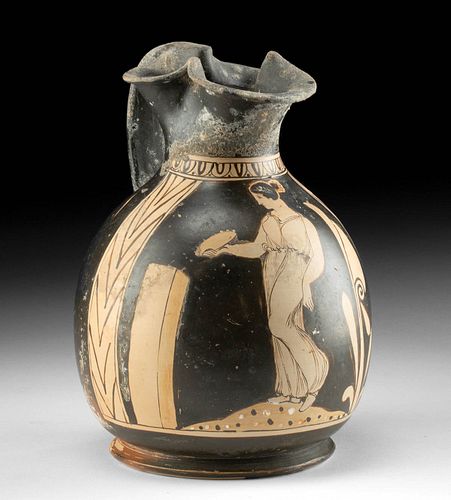Greek Red Figure Trefoil Oinochoe, Woman at Altar
Lot 28b
About Seller
Artemis Fine Arts
686 S Taylor Ave, Ste 106
Louisville, CO 80027
United States
Selling antiquities, ancient and ethnographic art online since 1993, Artemis Gallery specializes in Classical Antiquities (Egyptian, Greek, Roman, Near Eastern), Asian, Pre-Columbian, African / Tribal / Oceanographic art. Our extensive inventory includes pottery, stone, metal, wood, glass and textil...Read more
Categories
Estimate:
$3,600 - $5,400
Absentee vs Live bid
Two ways to bid:
- Leave a max absentee bid and the platform will bid on your behalf up to your maximum bid during the live auction.
- Bid live during the auction and your bids will be submitted real-time to the auctioneer.
Bid Increments
| Price | Bid Increment |
|---|---|
| $0 | $25 |
| $300 | $50 |
| $1,000 | $100 |
| $2,000 | $250 |
| $5,000 | $500 |
| $10,000 | $1,000 |
| $20,000 | $2,500 |
| $50,000 | $5,000 |
| $100,000 | $10,000 |
| $200,000 | $20,000 |
About Auction
By Artemis Fine Arts
Mar 24, 2022
Set Reminder
2022-03-24 10:00:00
2022-03-24 10:00:00
America/New_York
Bidsquare
Bidsquare : Exceptional Antiquities Ethnographic Fine Art
https://www.bidsquare.com/auctions/artemis-gallery/exceptional-antiquities-ethnographic-fine-art-9057
Museum-worthy examples of classical antiquities (Egyptian, Greek, Roman, Near Eastern), Viking, Far East / Asian, Pre-Columbian, African / Tribal, Oceanic, Native American, Spanish Colonial, Fossils, Ancient Jewelry, Fine / Visual Arts, so much more! Artemis Fine Arts info@artemisgallery.com
Museum-worthy examples of classical antiquities (Egyptian, Greek, Roman, Near Eastern), Viking, Far East / Asian, Pre-Columbian, African / Tribal, Oceanic, Native American, Spanish Colonial, Fossils, Ancient Jewelry, Fine / Visual Arts, so much more! Artemis Fine Arts info@artemisgallery.com
- Lot Description
Magna Graecia, South Italic, most likely Campania, ca. early 4th century BCE. Simply divine in form and decoration; a marvelous pottery oinochoe displaying a bulbous body and a sloped shoulder that narrows to a slender neck and a trefoil spout, all sitting upon an applied ring-shaped foot with a ribbon-form handle that gracefully connects rim to shoulder. Enveloped in a rich black glaze, the elegant vessel boasts skillfully painted red-figure decoration on 1 side of its body featuring a woman at an altar standing in contrapposto. The elegant lady faces left as her right hand holds out a libation bowl toward a 4-sided pillar and her left arm hangs to her side. A floor-length peplos drapes her slender figure, tied at the waist to accentuate the voluptuous curves of her feminine physique. Size: 5.8" Diameter x 7.2" H (14.7 cm x 18.3 cm)
Her graceful visage is angled slightly downward, gazing toward the altar, and displaying a somber countenance with petite eyes, a straight nose, and a down-turned mouth, all topped by a neat coiffure pulled back into a bun and crowned by a wreath of laurel leaves. A tree resembling half of a palmette rises behind her, while a pair of vertical registers filled with angled striations flank the scene and a brief horizontal band of tongue motif is shown above.
Virtually no ancient Greek paintings have survived the tests of time. This makes the painted compositions found on ceramic vessels like this example invaluable sources of information about ancient Greek visual art. Refined vessels like this oinochoe were not merely utilitarian pottery, but rather works of art in their own right, highly prized throughout the classical world.
Perhaps the most exciting innovation in Greek vase painting was the red-figure technique, invented in Athens around 525 BCE and beloved by other artists of Magna Graecia. The red-figure technique allowed for much greater flexibility as opposed to the black-figure technique, for now the artist could use a soft, pliable brush rather than a rigid metal graver to delineate interior details, play with the thickness of the lines, as well as build up or dilute glazes to create chromatic effects. The painter would create figures by outlining them in the natural red of the vase, and then enrich these figural forms with black lines to suggest volume, at times perspectival depth, and movement, bringing those silhouettes and their environs to life. Beyond this, fugitive pigments made it possible for the artist to create additional layers of interest and detail as we see in this example.
Provenance: private East Coast collection, New York, New York, USA, acquired before 2010
All items legal to buy/sell under U.S. Statute covering cultural patrimony Code 2600, CHAPTER 14, and are guaranteed to be as described or your money back.
A Certificate of Authenticity will accompany all winning bids.
PLEASE NOTE: Due to recent increases of shipments being seized by Australian & German customs (even for items with pre-UNESCO provenance), we will no longer ship most antiquities and ancient Chinese art to Australia & Germany. For categories of items that are acceptable to ship to Australia or Germany, please contact us directly or work with your local customs brokerage firm.
Display stands not described as included/custom in the item description are for photography purposes only and will not be included with the item upon shipping.
#170787Expected nicks and abrasions, as well as a few minor chips, all commensurate with age. Some small areas of repainting. Otherwise, intact and excellent with impressive remaining pigments and detail.Condition
- Shipping Info
-
All shipping is handled in-house for your convenience. Your invoice from Artemis Gallery will include shipping calculation instructions. If in doubt, please inquire BEFORE bidding for estimated shipping costs for individual items.
-
- Buyer's Premium



 EUR
EUR CAD
CAD AUD
AUD GBP
GBP MXN
MXN HKD
HKD CNY
CNY MYR
MYR SEK
SEK SGD
SGD CHF
CHF THB
THB















